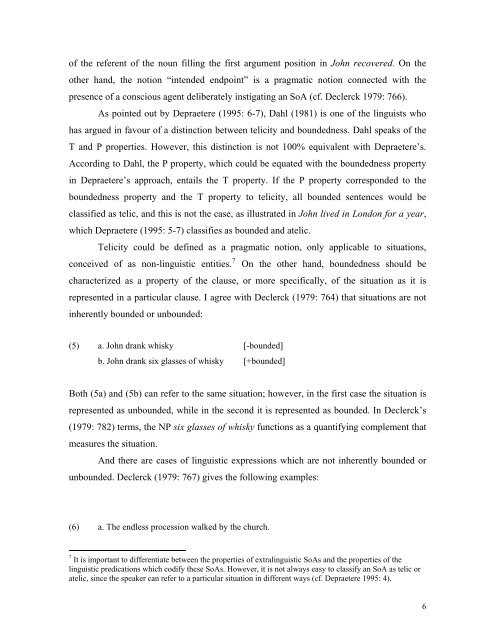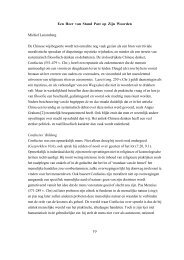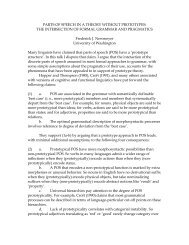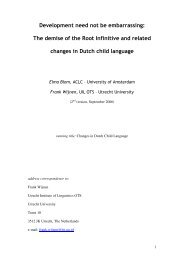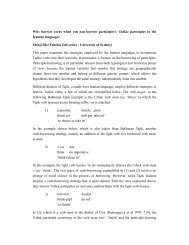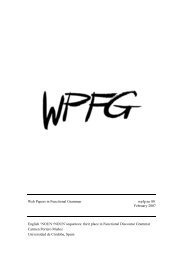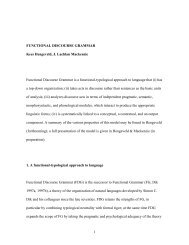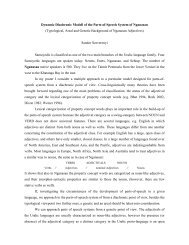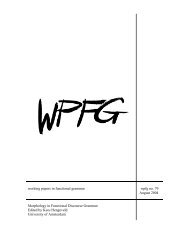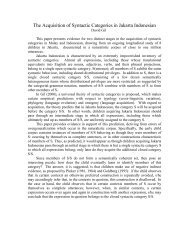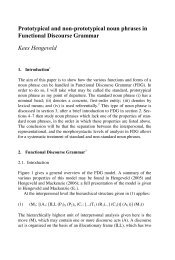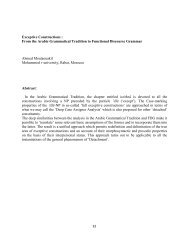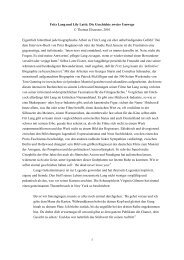Reconsidering aspectuality: interrelations between grammatical
Reconsidering aspectuality: interrelations between grammatical
Reconsidering aspectuality: interrelations between grammatical
Create successful ePaper yourself
Turn your PDF publications into a flip-book with our unique Google optimized e-Paper software.
of the referent of the noun filling the first argument position in John recovered. On the<br />
other hand, the notion “intended endpoint” is a pragmatic notion connected with the<br />
presence of a conscious agent deliberately instigating an SoA (cf. Declerck 1979: 766).<br />
As pointed out by Depraetere (1995: 6-7), Dahl (1981) is one of the linguists who<br />
has argued in favour of a distinction <strong>between</strong> telicity and boundedness. Dahl speaks of the<br />
T and P properties. However, this distinction is not 100% equivalent with Depraetere’s.<br />
According to Dahl, the P property, which could be equated with the boundedness property<br />
in Depraetere’s approach, entails the T property. If the P property corresponded to the<br />
boundedness property and the T property to telicity, all bounded sentences would be<br />
classified as telic, and this is not the case, as illustrated in John lived in London for a year,<br />
which Depraetere (1995: 5-7) classifies as bounded and atelic.<br />
Telicity could be defined as a pragmatic notion, only applicable to situations,<br />
conceived of as non-linguistic entities. 7 On the other hand, boundedness should be<br />
characterized as a property of the clause, or more specifically, of the situation as it is<br />
represented in a particular clause. I agree with Declerck (1979: 764) that situations are not<br />
inherently bounded or unbounded:<br />
(5) a. John drank whisky [-bounded]<br />
b. John drank six glasses of whisky [+bounded]<br />
Both (5a) and (5b) can refer to the same situation; however, in the first case the situation is<br />
represented as unbounded, while in the second it is represented as bounded. In Declerck’s<br />
(1979: 782) terms, the NP six glasses of whisky functions as a quantifying complement that<br />
measures the situation.<br />
And there are cases of linguistic expressions which are not inherently bounded or<br />
unbounded. Declerck (1979: 767) gives the following examples:<br />
(6) a. The endless procession walked by the church.<br />
7 It is important to differentiate <strong>between</strong> the properties of extralinguistic SoAs and the properties of the<br />
linguistic predications which codify these SoAs. However, it is not always easy to classify an SoA as telic or<br />
atelic, since the speaker can refer to a particular situation in different ways (cf. Depraetere 1995: 4).<br />
6


